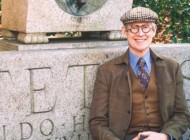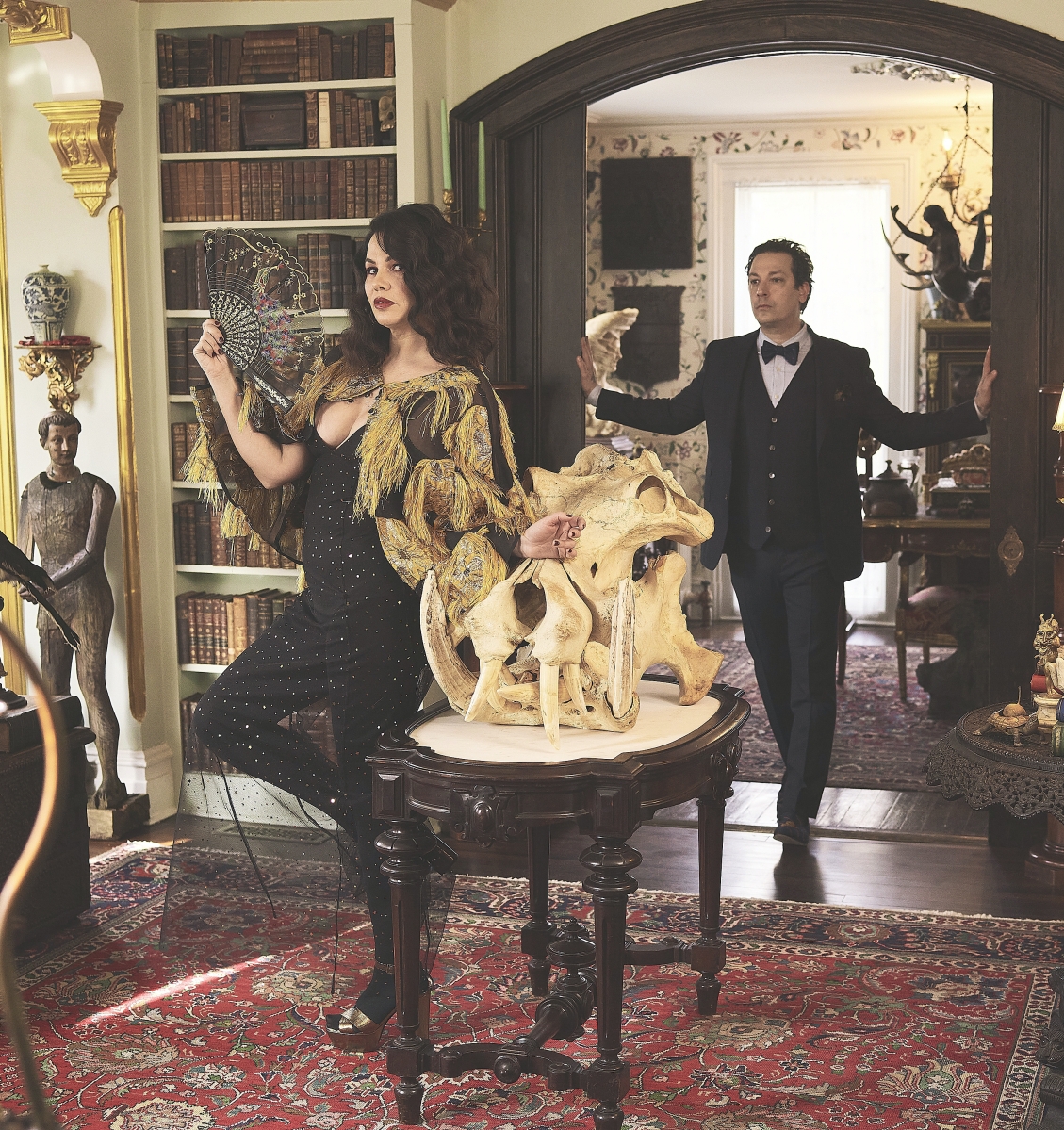
Ryan Matthew Cohn and Regina Marie Cohn in their home.
Photo courtesy of Ryan M. Cohn.
Ryan Matthew Cohn and Regina Marie Cohn are the founders and operators of the Oddities Flea Market. Ryan is known as a host on the television series Oddities (2010-14) and has since expanded his career to fine art commissions and installations. Regina has an extensive background in the fashion industry and is now executive producer of the market and their many other projects. Antiques and The Arts Weekly visited the couple at their home to discuss their careers, collection and upcoming events.
How did the Oddities Flea Market, which has now become a movement within the antiques field, come to be?
Regina: It was my idea, on a whim! I had just retired from almost 20 years in the fashion industry, and I was constantly jealous of all the fun that Ryan was having.
Ryan: I was traveling the world while Regina was locked up in a store, working weekends and holidays.
Regina: I wanted to figure out a way for us to work together and evolve his projects. People were doing commissions and markets on a smaller scale, but they were coming from an artist’s background and not a business background, so I felt very confident that I could expand on that, run it like a business and make it huge.
Ryan: We had a lot of different people that we worked with but didn’t really have a place to house all these talents that we knew collectively, and this was a great opportunity to do that.
Regina: In March 2017, I decided to throw the first market in this dive of a building in Greenpoint, Brooklyn, with three carpeted floors… a filthy venue. We asked all of our friends in the community if they were interested in vending, and asked Mike and Evan [of Obscura Antiques from Oddities] to use their name. It was a huge success; we had to cut the line at 5 pm because we had no idea that thousands of people would show up. We had to turn some away. Of course, we had to do it again with a two-day event, and the show just grew from there.
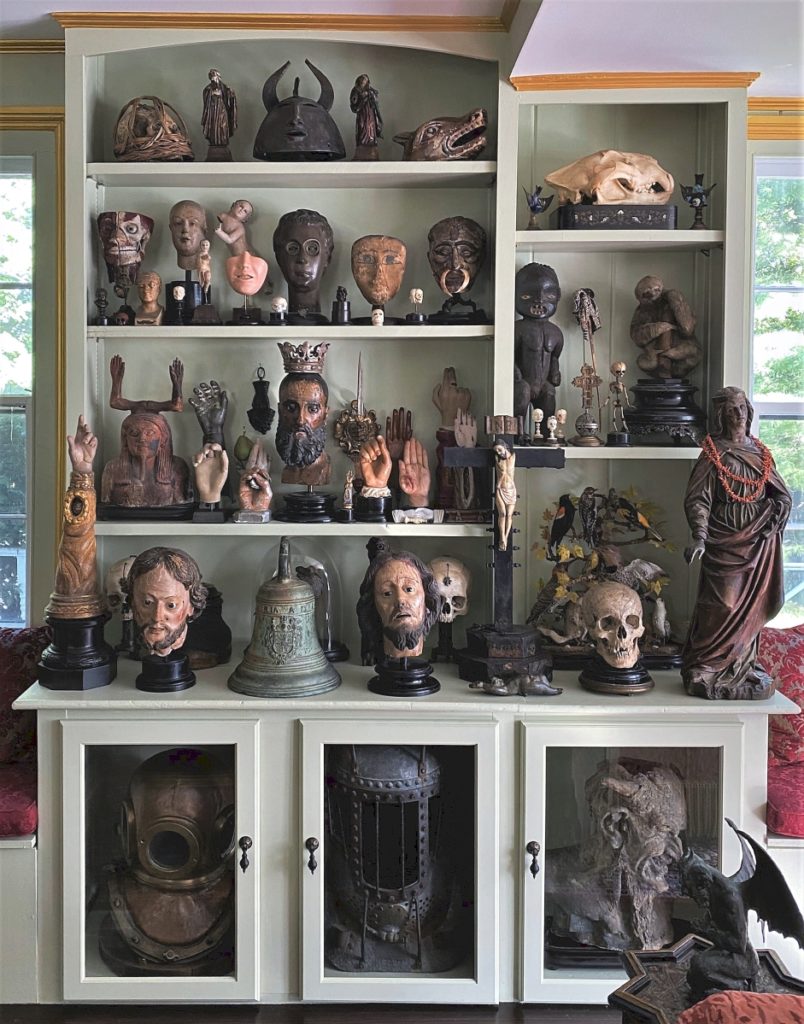
Assembly of santos figures, reliquaries and other artifacts dated up to the Nineteenth Century.
What distinguishes the Oddities Flea Market from standard antiques and art shows?
Ryan: Well, we certainly have an emphasis on oddities! We focus on things that are slightly out of the ordinary; natural history, anatomy, scientifica and other such things. That could be a jewelry maker, an artist that does illustrations or someone who sells antiques. We have all of that under one roof.
Regina: We take our time with applications and only choose the best of the best. We also try to inspire them to get more creative, push their boundaries and do exclusive products for our events. We provide preemptive information such as, “our following is mostly female, think about this when you’re curating your table.” We want them to succeed.
Ryan: We’re like the coaches in the community.
In addition to the market, you also curate and install exhibitions. Tell us more about that process.
Ryan: I just completed one in a really cool mansion in Irvington, N.Y., the Armour-Stiner Octagon House. One of the owners recognized me on a regular visit and commissioned me to turn an upstairs room into a cabinet of curiosities. We do installations in museums and peoples’ houses, even did New York Fashion Week before the pandemic hit.
Regina: We also did a lot with our bar in Brooklyn, House of Wax. It was so much easier for us to throw events in that space, again to promote active people in our community and keep everyone together because the markets were only once or twice a year.
Do you use your own collection for installations?
Ryan: A little bit of both. We always keep anything good because I know we’re going to use it for something.
Regina: Many of these museums don’t have a big budget, and we want to help them out. It’s something that Ryan loves to do. I’d say that 80 percent comes out of our personal collection.
As your careers have progressed, a new generation of collectors has grown with you. Do you think this bodes well for the future of antiques?
Ryan: I think it’s great! There are way more collectors now than when we started Oddities. A lot of people didn’t know that this genre existed until they watched the show, so that spawned more stores, too. It’s a double-edged sword; it’s definitely made it harder to find and also made the prices shoot up, but that’s also a good thing. We occasionally sell as well, but most of what we do is curate spaces and share our collection with the general public.
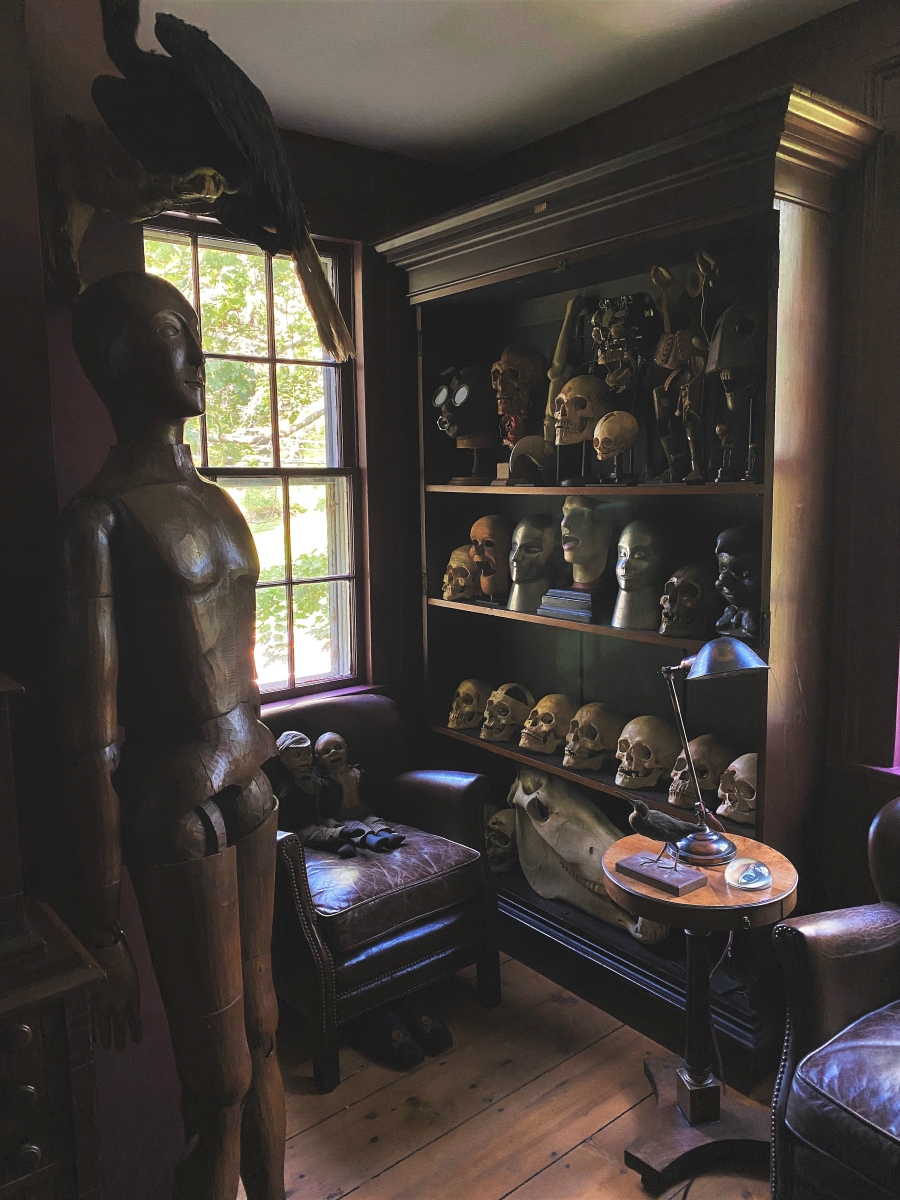
Full-sized artist’s mannequin and skull collection in the library.
How has moving from Brooklyn, N.Y., to Connecticut changed your business?
Ryan: We’re sort of at the forefront in the country now! New York was great and all, but now we’re in in a very old state, so we’re closer to antiques. We live in a beautiful Victorian town, and the estate sales here are mind-boggling! It doesn’t necessarily mean that we’re finding demonology books from the Fifteenth Century, but we did buy chairs that belonged to Bunny Williams.
Regina: Ryan’s being contacted by people in Connecticut and inviting him to their home, especially if they’re moving or selling something. The storage factor also stopped us in New York.
Ryan: We had eight storage units in and around New York City, New Jersey. And it’s really hard when you want to find something in your collection. The last place we had was a three-story brownstone and we moved into a place that was quadruple the size of that.
Regina: It was a disaster! When we first moved here, I was overwhelmed with all this space, thinking, “We don’t have children, I don’t want to clean it, we’re never going to fill up these properties, it’s going to look empty…”
Ryan: Do you know who you’re married to?
Regina: Then I turned to Ryan yesterday and said, “We’ve been here two years, why do I feel like our house is getting too small?” I shouldn’t have said that, it’s going to give him ideas.
Ryan: I thought it was going to take us years to fill. Well, we’re almost at capacity now. When we first moved here, we were fostering a kitten and we finally found him the right home. So now we have a giant room on our third floor that’s going to become a library or Wunderkammer.
Regina: I’m scared because it’s the last free room in our house, then Ryan’s going to run out of projects. I don’t know what’s next!
Ryan: We’re lucky because we have an actual chapel on the property. Any spillover merchandise or anything that doesn’t fit into the house usually goes in there until we figure out what to do with it. We haven’t touched the inside because it’s filled to the brim with antiques right now.
Regina: You can’t get in there!
What are your collecting criteria?
Ryan: It has to be rare, something that I don’t already have. I want things that tell a story. I tend to gravitate towards things that have a dark, mysterious or otherwise history to them. Even in our book collection, we have a lot of esoteric books like early bibles, books on witchcraft and demonology, anatomy and natural history.
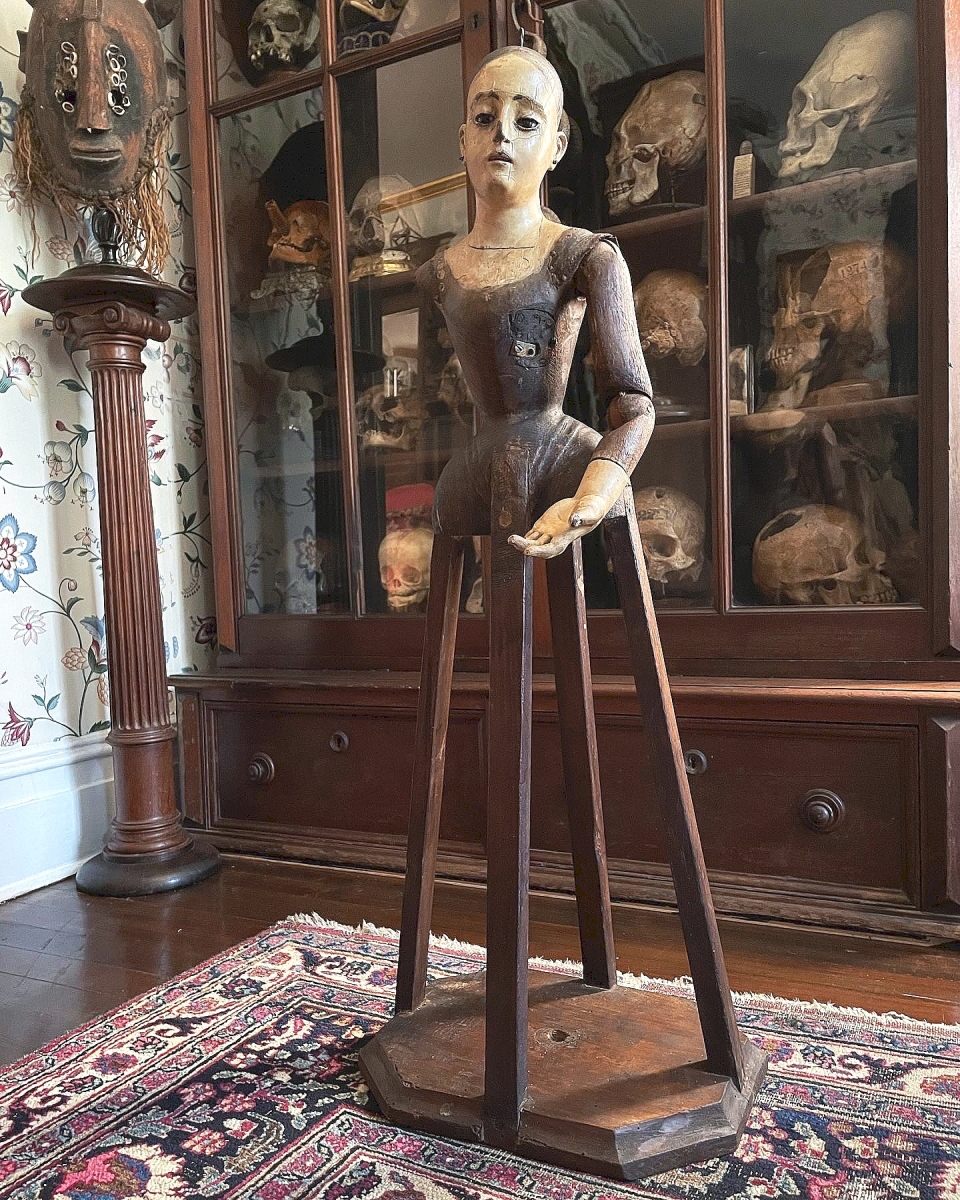
Eighteenth Century cage doll, likely Spanish. Photo courtesy of Ryan M. Cohn.
Care to share any of your favorite recent finds?
Ryan: I picked up an Eighteenth Century cage doll, which I think is Spanish. They’re usually Portuguese or Italian. She’s about 2½ or 3 feet with a very expressive face, the paint is really good and she’s distressed in all the right areas. The cage would have been covered by a dress. I’ve never owned a cage doll, but I have many santos figures, which are religious dolls that were either used in churches or personal collections for worship.
What is it that draws collectors to the strange and unusual?
Ryan: Many people like us strive to find out the history of every single object that we come across, and almost everyone has an interest in the unknown, or something that may be uncomfortable to learn about. And then you have the other sect of people that actually want to own those things. It’s just like anyone else in antiques; you could be collecting thimbles or collecting books on witchcraft. I just think there are more people sharing their love for oddities — more than there ever was before.
[On sourcing the strange] People sell out of it! I’ll almost always hear that they can’t keep the stuff on the shelves. When we walk into an antiques store, I ask for the most expensive things because those will most likely be of the most interest. We still travel to Europe and have a huge interest in everything pre-Nineteenth Century. It’s everywhere there.
Regina: And when he complains that he can’t find anything here, I remind him that it’s all his fault!
Ryan: Accidentally, yes.
The next Oddities Flea Market: New York will be December 10. For information, www.theodditiesfleamarket.com.
Editor’s note: The Armour-Stiner Octagon House’s “Myths & Mysteries” installation is on view through October 31. Atlas Obscura will host a series of monthly virtual events, “Antiques and Their Afterlives: Stories From the Collection of Ryan and Regina Cohn,” beginning in October.
— Z.G. Burnett


